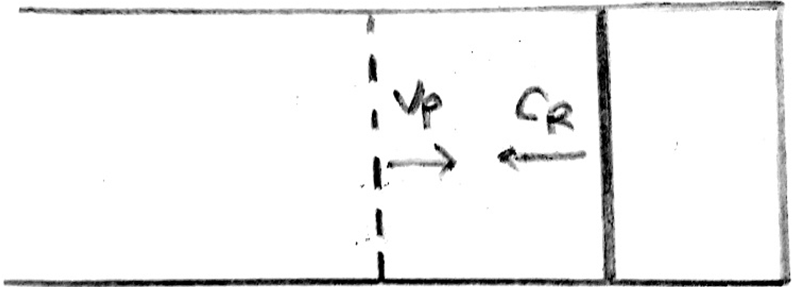This set of Gas Dynamics Multiple Choice Questions & Answers (MCQs) focuses on “Reflected Shock Wave”.
1. The velocity of the fluid behind the reflected shock wave inside the tube is ________
a) > velocity ahead of the shock
b) = velocity ahead of the shock
c) Infinite
d) Zero
View Answer
Explanation: As the shock gets reflected from the tub walls and travels back, the strength of the shock is such that the originally induced fluid motion with velocity behind the shock is completely stopped. Hence the fluid velocity behind the reflected shock becomes zero.
2. The zero velocity boundary condition is kept by the reflected shock.
a) True
b) False
View Answer
Explanation: The purpose of the reflected shock wave is to deflect the upstream flow such that it parallel to the wall after getting reflected from shock. As a result of this zero velocity boundary condition is satisfied at the wall.
3. The strength of the reflected shock is _______ compared to the incident shock.
a) Weaker
b) Stronger
c) Nullified
d) Equal
View Answer
Explanation: As the flow passes through the incident wave its Mach number decreases as it moves downstream, i.e. M2 < M1. Now this M2 becomes the upstream Mach number M1 for the reflected wave, and since the deflection angles are the same for both incident and reflected waves, while reflected shock has lower upstream Mach number, the strength of the reflected wave is weaker than the incident wave.
4. As per the below figure, what will be the velocity of gas ahead of the shock?

a) CR
b) Vp
c) CR + Vp
d) CR – Vp
View Answer
Explanation: Since the shock represented in the figure is the reflected shock wave, as the shock moves upstream the velocity of gas relative to the shock wave is CR + Vp.
5. The shock angle of the reflected shock will be _______
a) β = 90°
b) β > 90°
c) β < 90°
d) β = 0°
View Answer
Explanation: When the incident wave gets reflected from the wall boundary, it tends to turn inwards to itself. Therefore such waves are referred to as compression waves, and hence the reflected waves are oblique shock waves for which shock angle is always < 90°.
6. If the shock angle of the incident wave and reflected wave is β1 and β2 respectively, then __________
a) β1 = β2
b) β1 < β2
c) β1 > β2
d) β2 = 0.
View Answer
Explanation: As the wave gets reflected from the wall according to general shock characteristics, its Mach number decreases. Hence the reflected wave now has a lower upstream Mach number than the incident wave, due to which the reflected wave has a lower shock angle than an incident wave, i.e. β1 > β2.
7. If the Mach number of the incident shock is 2.3, then obtain the Mach number of the reflected wave.
a) 1.39
b) 1.87
c) 2.04
d) 2.67
View Answer
Explanation: From the theory of the reflected shock the Mach number of the incident and the reflected shock are related by;
\(\frac {M_R}{M_R^2-1}=\frac {M_s}{M_s^2-1} \sqrt {1+\frac {2(γ-1)}{(γ+1)^2}\frac {γM_s^2+1}{M_s^2 }(M_s^2-1)}\)
Then substituting the value of Mach number for an incident shock wave, i.e. Ms = 2.3
\(\frac {M_R}{M_R^2-1}\) = 0.748 (γ = 1.4)
On solving above quadratic equation, MR = 1.87
8. For the shock wave reflection from the open end, which of the following condition is satisfied?
a) Pressure boundary condition
b) Temperature boundary condition
c) Velocity boundary condition
d) Density boundary condition
View Answer
Explanation: When the Shock wave is incident on the open end, it either gets reflected into compression or expansion wave, to adjust the flow pressure with the boundary pressure. Hence for a shock wave reflection from the open end, the pressure boundary condition is satisfied.
Sanfoundry Global Education & Learning Series – Gas Dynamics.
To practice all areas of Gas Dynamics, here is complete set of Multiple Choice Questions and Answers.
If you find a mistake in question / option / answer, kindly take a screenshot and email to [email protected]
